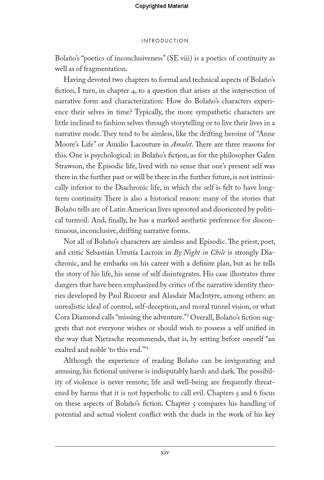Copyrighted Material
Introduction
Bolaño’s “poetics of inconclusiveness” (SE viii) is a poetics of continuity as well as of fragmentation. Having devoted two chapters to formal and technical aspects of Bolaño’s fiction, I turn, in chapter 4, to a question that arises at the intersection of narrative form and characterization: How do Bolaño’s characters experience their selves in time? Typically, the more sympathetic characters are little inclined to fashion selves through storytelling or to live their lives in a narrative mode. They tend to be aimless, like the drifting heroine of “Anne Moore’s Life” or Auxilio Lacouture in Amulet. There are three reasons for this. One is psychological: in Bolaño’s fiction, as for the philosopher Galen Strawson, the Episodic life, lived with no sense that one’s present self was there in the further past or will be there in the further future, is not intrinsically inferior to the Diachronic life, in which the self is felt to have longterm continuity. There is also a historical reason: many of the stories that Bolaño tells are of Latin American lives uprooted and disoriented by political turmoil. And, finally, he has a marked aesthetic preference for discontinuous, inconclusive, drifting narrative forms. Not all of Bolaño’s characters are aimless and Episodic. The priest, poet, and critic Sebastián Urrutia Lacroix in By Night in Chile is strongly Diachronic, and he embarks on his career with a definite plan, but as he tells the story of his life, his sense of self disintegrates. His case illustrates three dangers that have been emphasized by critics of the narrative identity theories developed by Paul Ricoeur and Alasdair MacIntyre, among others: an unrealistic ideal of control, self-deception, and moral tunnel vision, or what Cora Diamond calls “missing the adventure.”3 Overall, Bolaño’s fiction suggests that not everyone wishes or should wish to possess a self unified in the way that Nietzsche recommends, that is, by setting before oneself “an exalted and noble ‘to this end.’”4 Although the experience of reading Bolaño can be invigorating and amusing, his fictional universe is indisputably harsh and dark. The possibility of violence is never remote; life and well-being are frequently threatened by harms that it is not hyperbolic to call evil. Chapters 5 and 6 focus on these aspects of Bolaño’s fiction. Chapter 5 compares his handling of potential and actual violent conflict with the duels in the work of his key
xiv
